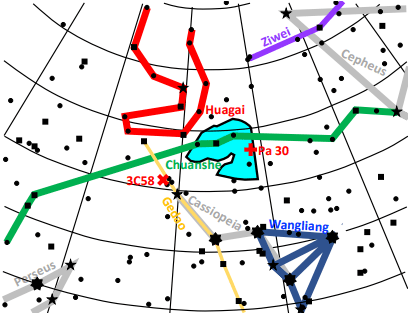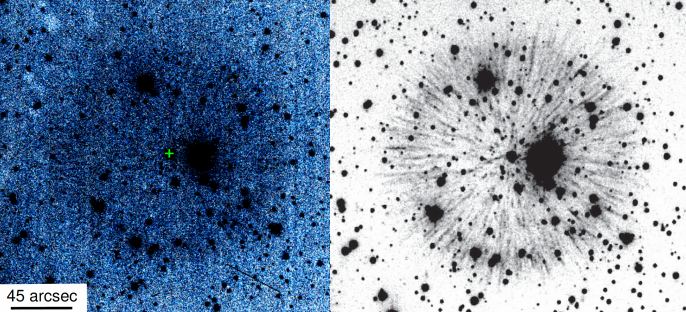In 2013, amateur astronomer Dana Patchick was looking through images from the Wide-field Infrared Survey Explorer archive and discovered a diffuse, circular object near the constellation of Cassiopeia. He found this apparent nebula was interesting because it was bright in the infrared portion of the spectrum, but virtually invisible in the colors of light visible to our eyes. Dana added this item to the database of the Deep Sky Hunters amateur astronomers group, believing it was a planetary nebula – the quiet remnant of stars in mass similar to the sun. He named it PA 30.
However, professional astronomers who picked it up from there realized that this object is far more than it first seemed. It is, they now believe, the remnant of a lost supernova observed in 1181. And an extremely rare type at that.
The Guest Star
In early August of 1181 CE, a “guest star” appeared in the constellation we now know as Cassiopeia, known then to Chinese astronomers as Wangliang. Both Chinese and Japanese astronomers recorded the appearance of the star and state that it remained visible for 185 days, unmoving with respect to other stars.
In 1971, astronomers first realized that this “guest star” was almost certainly a supernova due to how long it remained visible in the night sky. This made the initial observation an extremely rare reporting of a historical supernova.
Supernovae are believed to occur, on average, about once per century in galaxies like the Milky Way but, because they may be obscured if they are on the far side of the galaxy and obscured by the heavy dust lanes, not all will be visible to us. Ultimately, this made SN 1181 one of less than a dozen suspected supernovae in recorded history prior to the rise of modern astronomy. And of those, only four had been conclusively tied to an observational remnant. While astronomers are confident that these historical supernovae were indeed supernovae, without having an identified remnant, it is impossible to determine the type of supernovae.
Previously, SN 1181 had been potentially associated with a pulsar known as 3C 58, but attempts at determining the age of this object suggested it was far too old to be associated with the Chinese records.
PA 30
Although PA 30 was initially flagged as a potential planetary nebula, it quickly became apparent that it was anything but.
Just a year after its discovery, astronomers examined the object. With planetary nebulae, the central star has shed most of its outer layers resulting in the still extremely hot core of the star being exposed. The radiation from this star will heat the nebula created causing emission lines in the spectra. However, these emission lines were absent in the spectrum of PA 30.
Follow-up observations were conducted in 2016 (published in 2021). These revealed winds from the central star at “unprecedented” speeds of 16,000 km/sec (5% the speed of light). Emission lines were found from the central star of highly ionized oxygen and carbon but both the central star and nebula lacked hydrogen and helium. The nebula was expanding with speeds of roughly 1,100 km/sec – as much as 100x the expansion speed of a typical planetary nebula.
However, these features don’t entirely line up with the expectations for a supernova either. First, the expansion speed of the nebula was lower than most supernovae ejecta. Second, even in most supernovae, hydrogen and helium should be present as it is the outer layer of the stars getting blasted off in the explosion.
A potential explanation for these characteristics came in 2019. There, astronomers suggested that the supernova was caused by the merger of two white dwarfs which were both already depleted of these lighter elements as they released their atmospheres at the end of their main sequence lifetimes. Specifically, astronomers proposed that this was the merger of a white dwarf with a carbon/oxygen atmosphere with one with an oxygen/neon atmosphere creating an exceptionally rare type of supernova known as a SN Type Iax.
This proposition solves both of the problems. The previous loss of the atmospheres explains why hydrogen and helium were not present. Also, this type of supernova does not have as big of a bang as others, explaining the lower than anticipated expansion rate.
Further study supported this. Digging deeper into the spectra, the study found that the spectra had higher abundances than anticipated of neon and magnesium, which are the results of carbon fusion. This made PA 30 the only known supernova of this type within our galaxy.
The early research suggested that the stellar remnant may have extremely strong magnetic fields that powered the strong winds. However, more recent spectral analysis has suggested the remnant boasts a more modest magnetic field.
But was it associated with SN 1181?
Association
The first association between the object and the historic supernova was made in 2021. There, astronomers estimated the size of the nebula’s fastest expanding shell to be 2.2 parsecs, based on its apparent size and distance. This could then be compared to the previously discovered expansion speeds to estimate the age. Doing so suggested the age of the triggering event was roughly 990 years ago.
The astronomers realized this was reasonably well matched to the 1181 supernova. It was also much better aligned to the position of the reported supernova than the previously suspected object 3C 58.
Another study explains how: Records from China and Japan indicate that the star was “in the Kui lunar lodge”, near the “fifth star of Chuanshe“, “beside [the constellation of] Ziwei“, and “near [the constellation of] Wangliang.”
Taken together, these descriptions form a series of constraints describing the area in which the supernova remnant should be found. PA 30 falls within it while the other candidate, 3C 58, does not.

Ultimately, all signs point to PA 30 as the remnant of SN 1181. This makes it the sixth supernova remnant that has been positively associated with an observation of a supernova within our own galaxy. That proximity will allow the aftermath to be studied in unprecedented detail for this rare type of supernova.

